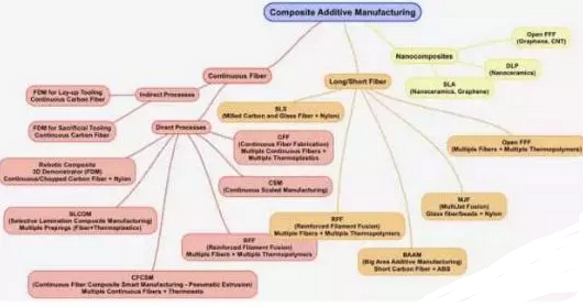In 2026, the global 3D printing composites market will exceed 500 million U.S. dollars
As one of the purest digital manufacturing methods, 3D printing is growing properly every year in terms of market size and development speed.It involves computers and machinery.The most important factor is advanced material science, especially computer materials.Aditive manufacturing automation has the greatest impact.
SmarTech's latest publication "3D▁Printing Commission Market-2017:Opportunity Analysis and Ten-Year Forecast provides an in-depth and accurate assessment of 3D printing composers.It is said that by 2026, the global revenue of 3D printing composers will exceed 500 million US dollars, composed the most important market opportunity for 3D printing ten years.
 Charts of composite materials currently available for 3D printing
Charts of composite materials currently available for 3D printing
3D printing is regarded by the industry as a way to simplify and automate the production process. It preserves the advantages of fiber composite materials in terms of weight optimization and strength. For the polymer 3D printing industry, 3D printed composite parts represent a This is a more direct approach to the production of industrial terminal components, including large and complex geometric components used in lightweight aircraft and automobiles.
Currently, there are two main types of 3D printing technologies that can use composite materials, namely Fused Deposition (FDM) and Powder Bed Melting (PBF), and the latter mainly refers to Selective Laser Sintering (SLS).
Extruded composite material
Composite extrusion molding manufacturing methods can be divided into several different application areas. Some are still in the research stage. The most practical FDM application is custom sacrificial tools, which means you can quickly 3D print out complex composite parts. Standard composite prepreg material tools, sacrificial tools take the manufacturing of parts to a new level-to manufacture highly complex composite parts without the need to assemble, just dissolve the 3D printed sacrificial tools in water, by Stratasys The ST 130 material produced can completely hold the shape of the composite part during the hot pressing process. It is currently the only system that can combine the mechanical properties of continuous fiber composite materials with the advanced geometry of 3D printing.
In the future, compound production will be fully automated. MarkForged is a 3D printing equipment manufacturer in the United States. It has developed a material extrusion technology that can place continuous fibers (carbon, glass or Kevlar) on 3D printed thermal polymer parts (mainly nylon). Between the printing layers, it is also the only commercial technology that can 3D print continuous fiber composite materials.
Other manufacturers and research institutions, mainly including the Più Laboratory of the Politecnico di Milano, are developing a technology using a six-axis robotic arm to extrude continuous fiber composite materials with the participation of thermosetting or photosensitive resin. However, these methods are still in the exploratory stage.
Strati is Local Motors' first 3D printed car, which is why so many 3D printer manufacturers are exploring the possibility of 3D printing long fiber composite materials (up to 3mm), most of which use ABS or nylon thermal polymers.
The most practical case comes from the BAAM (Large Size Additive Manufacturing) platform in Cincinnati, USA. The Lawrence Livermore National Laboratory and Local Motors used BAAM and composite ABS-carbon fiber particles to print the entire body of a household electric car at one time.
Carbon fiber imparts better mechanical properties to thermally polymerized materials, and at the same time reduces the warpage that occurs due to the temperature difference during the hot extrusion process.
Using nylon carbon fiber composite particles, Stratasys has also taken a further step. It has developed an eight-axis robotic arm that can build large and complex structures by extruding materials that can be accurately placed in a three-dimensional space.
This platform is still in the testing phase, and Stratasys' partners Ford and Boeing are doing this work. In addition, other low-cost material extrusion manufacturers and wire manufacturers are developing and using long-fiber thermoplastic fibers. The use of nylon carbon fiber (up to 20-30% CF) is currently the most popular method.
Powder bed melting composite material
Powder bed fusion (PBF) is another area where short (several hundred microns) cut fiber composite materials may continue to be widely used. The market structure of PBF technology is very different, and the lowest price for entry-level SLS systems is 200,000 euros. Although the market has been dominated by EOS and 3D Systems in the past two decades, many new companies have joined in recent years, such as Prodways and Ricoh. HP has also joined this market and has developed a PBF technology called MJF (Multi Jet Fusion), which is ten times faster than standard SLS.
Most companies will invite large chemical companies to develop new materials, mainly focusing on glass fiber (or glass beads) and carbon fiber nylon composite materials. The more active leaders in these fields are Arkema and BASF, and the leading position in composite powder technology for 3D printing is the Italian CRP Group and its Windform series of materials. These materials are mainly used for automotive and aerospace prototypes, but gradually they can also be used in the production of end parts.
Another 3D printing technology for continuous fiber composite materials that can be used for thermal polymer prepreg substrates is also under development. The SLCOM 1 system developed by EnvisionTEC uses a layering technology and prepreg rolls to manufacture 3D parts. The layered parts are first cut out, and then the polymer prepreg matrix is melted at a high temperature, and then placed in the appropriate position. The whole process can only be applied to the X and Y axes, and it does not show the same performance on the Z axis, but high-performance thermal polymers such as PEEK can be used to ensure the strength of the parts.
